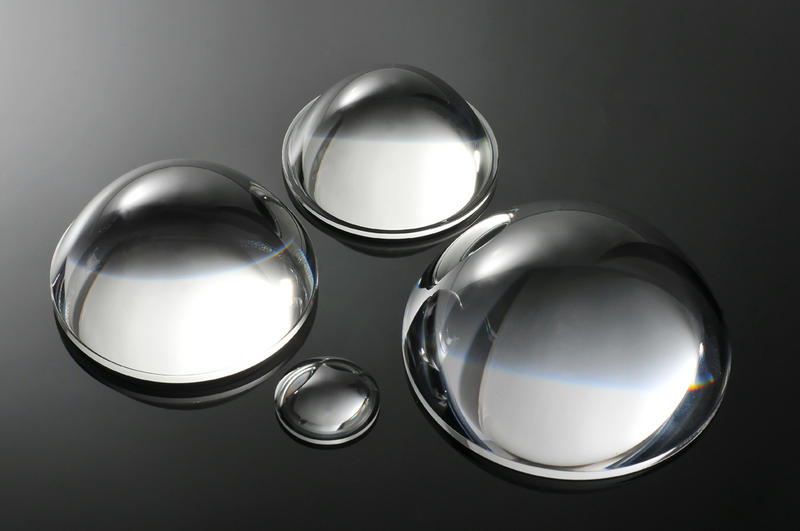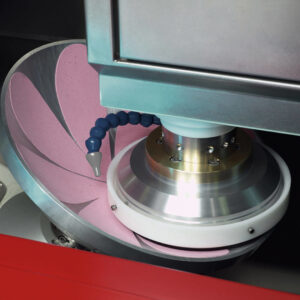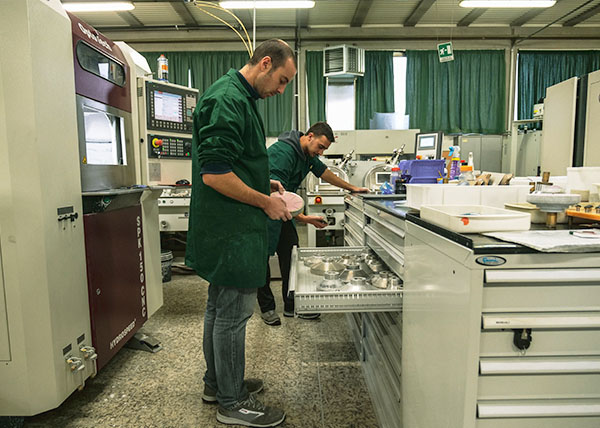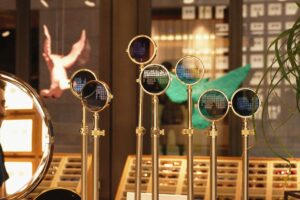Optical lenses are primarily classified based on their shape distinguishing between Spherical Lenses and Aspherical lenses (ASF). Each type presents unique characteristics, and the primary differences lie in the geometries and the complexity of production and measurement.

Aspherical lenses, characterized by a radius of curvature that varies from the center to the edge, possess a distinctive feature that provides optical advantages not found in their counterparts. In many cases, a single Aspheric lens can replace a more complex multi-lens system, leading to superior performance, cost-effectiveness, a more compact product, reduced dimension and weight compared to the multi-lens design.
Aspherical lenses are currently experiencing significant growth in the market.
According to Data Bridge Market Research[1], the Aspheric lenses market is projected to reach USD 188.13 million by 2030, compared to its value of USD 115.40 million in 2022 with a Compound Annual Growth Rate (CAGR) of 6.30% from 2023 to 2030.
Aspheric lenses are becoming standard in applications ranging from high-intensity photo lenses to aerospace technology, and modern manufacturing technologies have facilitated their economic and high-precision production, enabling their integration into cutting-edge systems like medical technology and laser material processing.
The increasing demand for transmitters and distance detectors, especially in the context of video surveillance, significantly contributes to market growth. Furthermore, the widespread utilization of Aspheric lenses in tablets and smartphones further contributed to this growth.
Aspherical lenses Overview
Aspherical lenses have a rotation symmetric Aspheric surface (parabolic, elliptical or hyperbolic) combined with a second surface, which can be spherical or flat and are normally used when an element must collimate or concentrate light. If a lens possesses two Aspheric surfaces is normally called as Biaspherical.
These lenses are used when is necessary to possess, with the same diameter and focal length of a similar Spherical lens, a minimum residual of spherical aberration, an optical effect which causes incident light rays to focus at different points when forming an image, creating a blur.
A perfectly designed and manufactured spherical lens, in fact, will still inherently exhibit spherical aberration. While Aspheric lenses, properly designed and fabricated, focuses light without producing any aberration.
Spherical lens systems require to be equipped with extra parts to resolve the aberrations problem, but when additional lens components are used to correct an image, the colour and flare change, contrast, and the lens’s weight and size go up. As a result of this, images produced by Aspherical lenses commonly have more colour and contrast.
While correcting spherical aberration stands out as the primary advantage of Aspheric lenses, it is not their only benefit. These lenses surpass their Spherical counterparts by delivering enhanced optical functionality, manifesting in sharper focusing, larger aperture size, and improved efficiency in light focusing and collection.
Versatile Applications of Aspherical Lenses
Thanks to their ability to correct spherical aberrations and various other optical imperfections, Aspherical lenses find applications across a broad spectrum of devices:
- Cameras
- Optical Instruments
- Eyeglasses and contact lenses
- Fiber Optics & Photonics
- Laser applications
- Mobile phone
Their versatility and ability to produce sharp and clear images allow them to be used in a wide range of applications, spanning from professional photographic equipment to wide-angle lenses, in the production of digital cameras, and surveillance systems. Aspheric IR lenses can also capture more defined images even in complete darkness, as they transmit more infrared light compared to a regular lens.
Aspheric lenses are highly appreciated in ophthalmology, both for crafting eyeglass lenses, to provide a broader field of view, reduce distortion, and ensure a flatter appearance, and for manufacturing contact lenses, contributing to enhancing clarity, especially in low-light conditions.
These lenses find use in the production of various optical devices, such as endoscopes, magnescopes, telescopes, and imaging devices, like microscopes and laser scanners, enabling engineers, researchers, and scientists to utilize advanced equipment for extremely precise measurements.
Traditionally, Aspheric lenses have been employed in the lighting industry as the first element near the light source to concentrate radiation, thanks to their ability to converge rays that strike them peripherally.
The advantage of reducing the number of elements in a spherical system with a single Aspheric element significantly contributes to weight reduction, a crucial factor in aerospace applications.
Design and Manufacturing of Aspherical lenses
The design and manufacture of Aspherical lenses can be challenging,however, leveraging modern machinery and advanced measuring technologies, it is now possible to produce Aspherical lenses in series with consistent and reproducible accuracy.
The manufacturing technologies for Aspherical lenses primarily include molding, polishing, and grinding methods. The production processes for Aspherical lenses have been significantly impacted by sophisticated CNC technology, intelligent control software, and new measuring techniques.
At Tecnottica, we have a dedicated area for the production of Aspherical lenses equipped with a Polishing machine, a highly flexible Grinding machine, Computer-numerical-control (CNC) equipment and Profilometers specifically designed for Asfpherical surfaces and free forms.
Precision Polishing Manufacturing
Our Polishing machine is equipped with Adaptive Deterministic Advanced Polishing Technology (ADAPT) and a Quality Control System (IQS). These technologies empower us to efficiently and consistently process highly accurate Aspherical and freeform shapes. Additionally, the system automatically adjusts for tool wear, compensating for any inaccuracies.
The Precision Polishing Manufacturing method involves working with small contact areas on the order of square millimeters to grind and polish Aspheric shapes. These minute contact areas are precisely adjusted in space during computer-controlled precision polishing to form the Aspheric profile.
Precision Grinding

We also utilize a highly flexible Grinding machine with an extended Y-axis and a modular spindle concept for processing wider workpiece geometries. This approach ensures the efficient and cost-effective production of premium optic surfaces.
Computer-numerical-control
Computer-numerical-control (CNC) equipment is necessary to shape and polish Aspherical surfaces, purely mechanical equipment is not adequate, since the radius of curvature is not constant over the clear aperture of the lens.
Since Aspherical surfaces must be produced on CNC equipment, they must be made one at a time; they cannot be shaped or polished in batches, and the optical Technician must program the CNC machine to accommodate the varying radius of curvature. This makes Aspherical surfaces considerably more expensive to produce than spherical surfaces.
Furthermore, the optical designer must carefully consider the specifics of the Aspherical surface so that the CNC equipment can accurately follow the complex curve. No comparable design challenge relates to spherical lens.
Metrology of Aspheres
Proper metrology is necessary to ensure an asphere meets all required tolerances.
The measurement of Aspheric lenses has become much faster and less complicated in recent years, measurement technologies have been optimized; one of the most common measurement technique for surface accuracy or figure error is profilometry.
Profilometry, a contactless precision measuring instrument for capturing the dimensions of Aspheres in 2D and 3D, measures the change in height of a lens by moving a probe across the surface. This is usually done in spirals or slices across the surface, building a cross section or a surface map of the height.
Other manufacturing methods
While this is our methodology employed for manufacturing Aspherical lenses, there are other techniques that can be utilized, depending on the lens’s substrate and its field of application. Here is a summary of the main ones to help understand their operations.
Precision Glass Molding
Precision glass molding is a manufacturing technique where optical glass cores are heated to high temperatures until the surface becomes malleable enough to be pressed into an Aspheric mold.
Diamond Turning
Single-point diamond turning (SPDT), similar to grinding and polishing, uses a smaller tool size, leading to better surface finishes and form accuracies. While SPDT is effective for shaping plastics, metal, and crystals, it is not suitable for working with glass.
Polymer Molding Technique
Polymer molding creates an Aspheric surface pressing a standard spherical surface onto an Aspheric mold created by SPDT. This method is effective for high-volume precision applications due to the initial tooling costs. However, the resulting lens has a reduced durability and is not suitable for harsh environments.
Plastic Injection Molding
Plastic injection molding includes two different techniques: Injecting molten plastic into an Aspheric mold and Compressing preheated plastic into an Aspheric mold, crucial for lenses with detailed structures, such as Fresnel lenses.
Injection and compression molding can be utilized combined in a process known as coining.
The cost-effectiveness and reduced weight of plastic make these lenses attractive for some designs. However, they have low resistance to scratches and, due to reduced thermal stability and pressure resistance, require special treatment before molding.
Our Competence in manufacturing Aspherical Lenses
 Tecnottica Consonni guarantees the processing of Aspherical Lenses offering expertise in different optical glass and Fused Silica. Our commitment extends beyond mere processing, encompassing the meticulous finishing of pre-molded Aspherical lenses in both glass and plastic.
Tecnottica Consonni guarantees the processing of Aspherical Lenses offering expertise in different optical glass and Fused Silica. Our commitment extends beyond mere processing, encompassing the meticulous finishing of pre-molded Aspherical lenses in both glass and plastic.
Our capabilities include the manufacturing of a diverse range of rotationally symmetric Aspheric profiles, achieved through the utilization of professional CNC machines. These machines, paired with our technical skills, enable the production of Aspherical lenses with diameters spanning from 2.5mm to 300mm.
Furthermore, our Aspherical lenses are not only crafted for versatility but are also available with Anti-Reflection coatings meticulously optimized to provide specific spectral bandwidths as defined by our customers. This dedication to customization ensures that our lenses meet the unique requirements of varied applications, including Astronomy, Biomedical/Medical, Communications, Industrial, Military, and Scientific Research.
Tecnottica Consonni stands at the forefront of Aspherical lens manufacturing, seamlessly blending precision, customization, and a diverse range of applications to deliver optical solutions of the highest quality.
[1] https://www.databridgemarketresearch.com/reports/global-aspheric-lenses-market
Photo Credits Tim Meyer Unsplash, Michel Oeler Unsplash, Logan Moreno Gutierrez Unsplash



